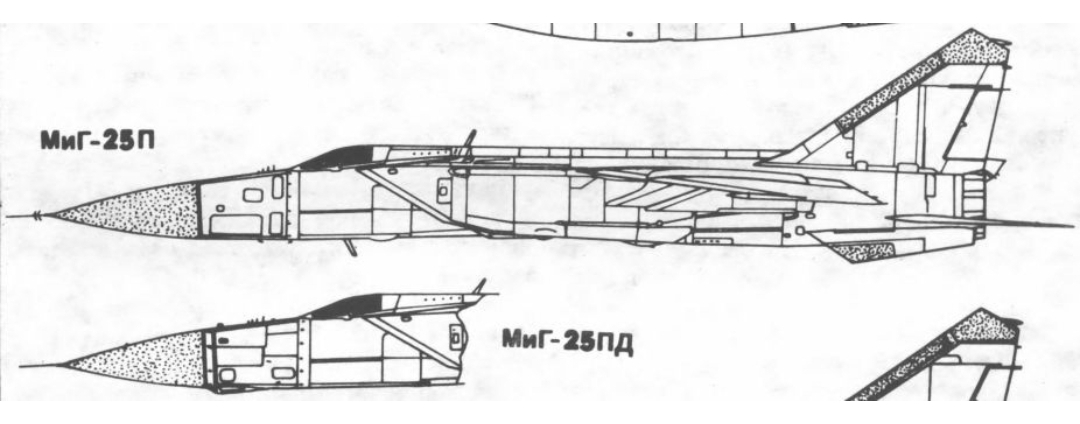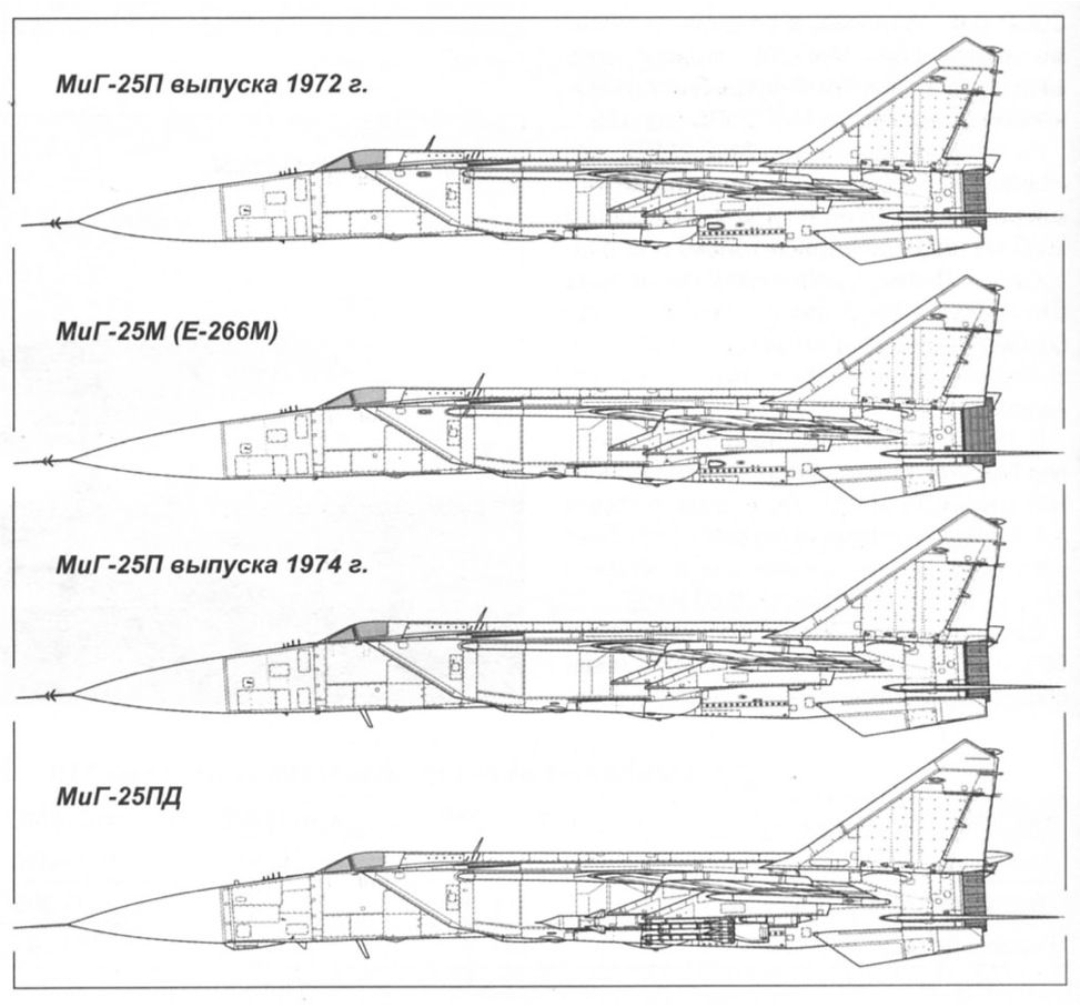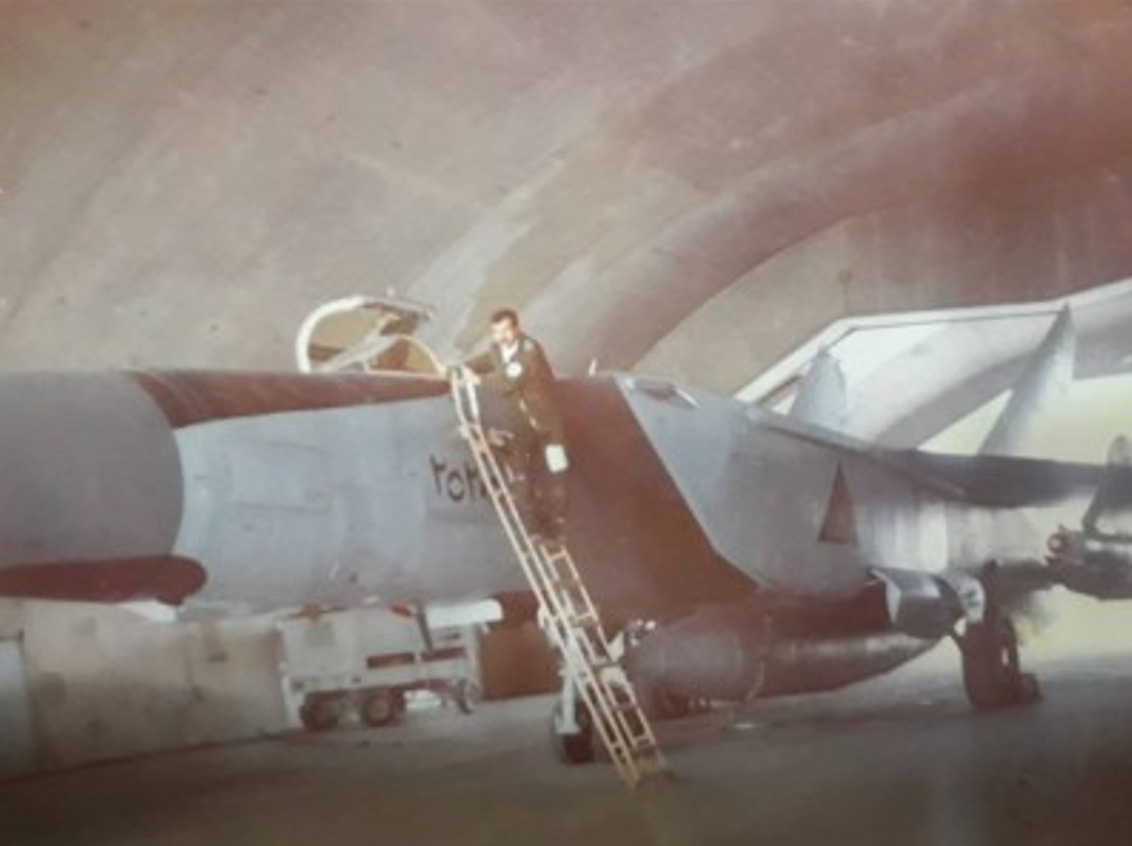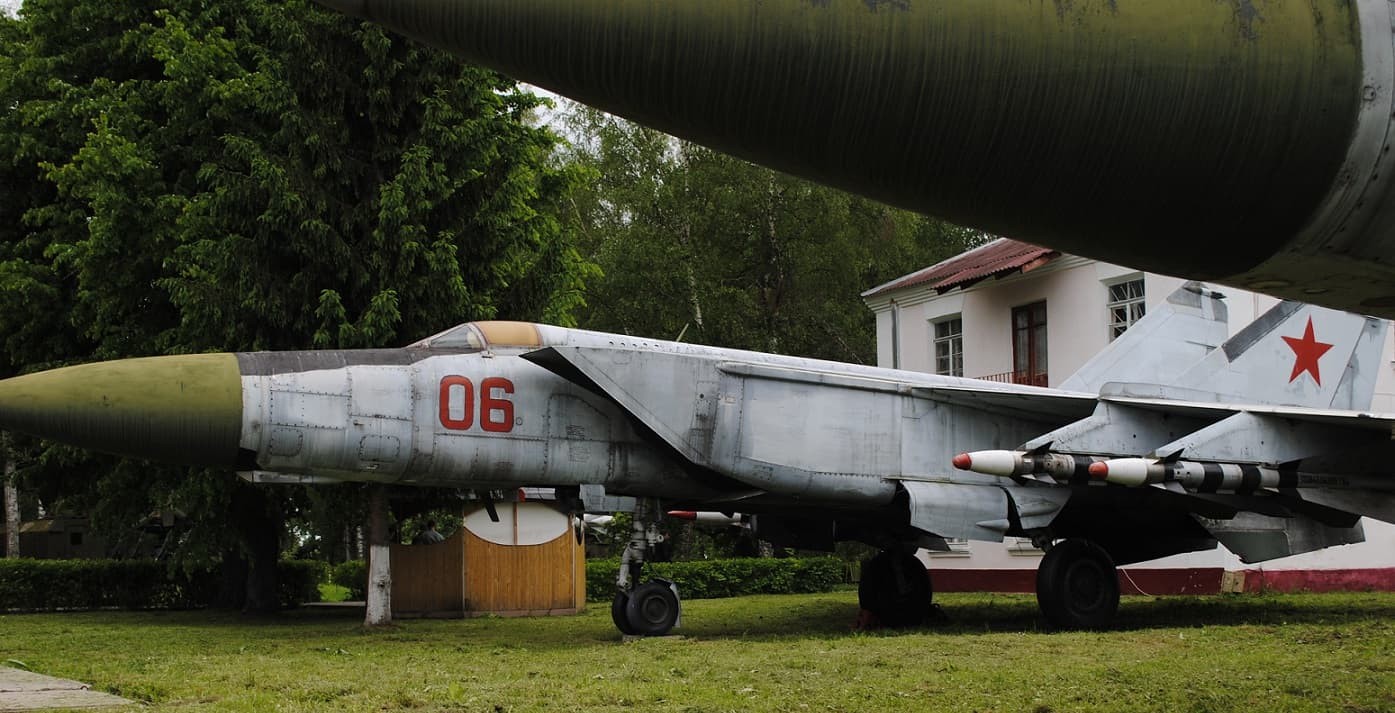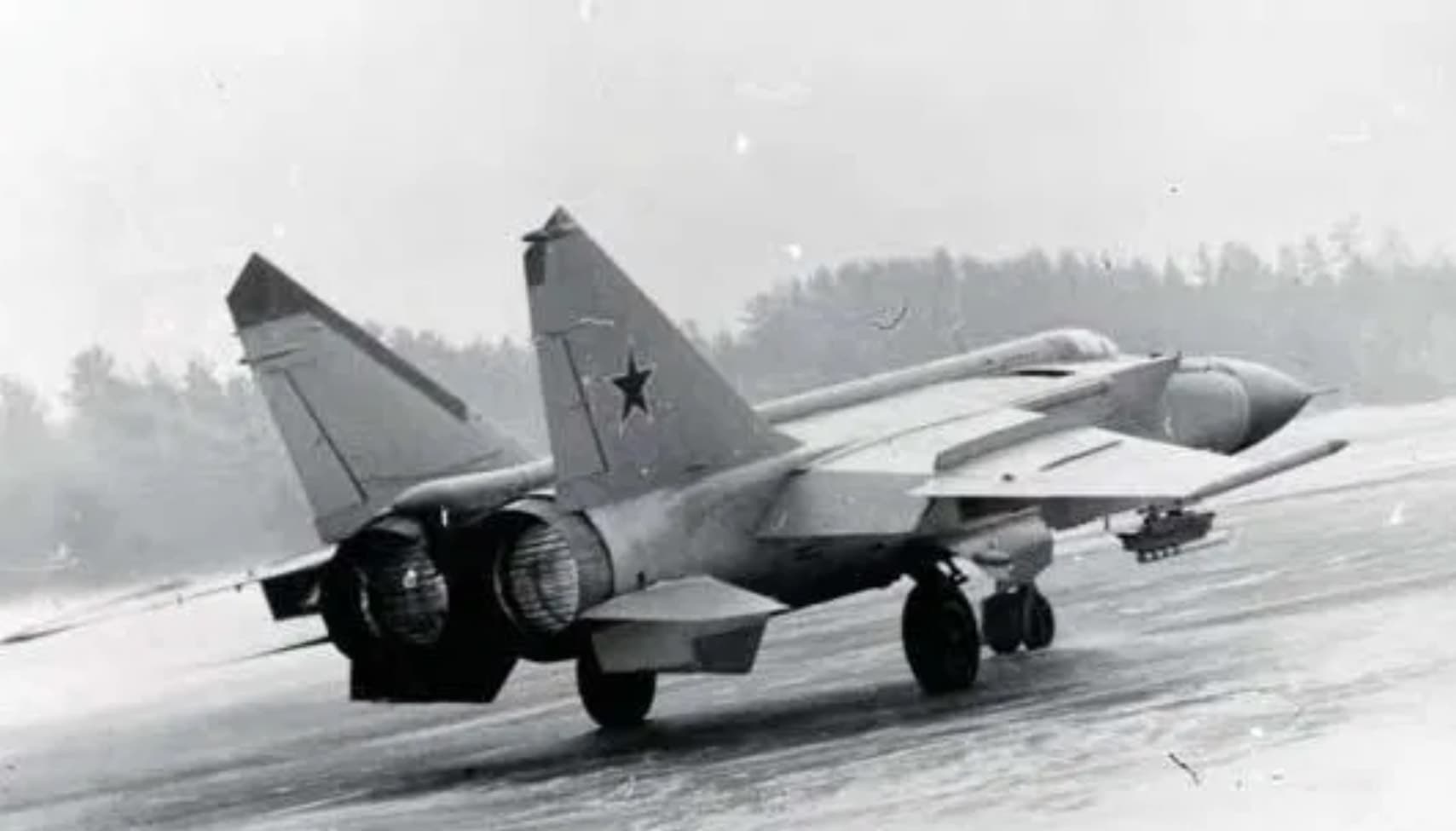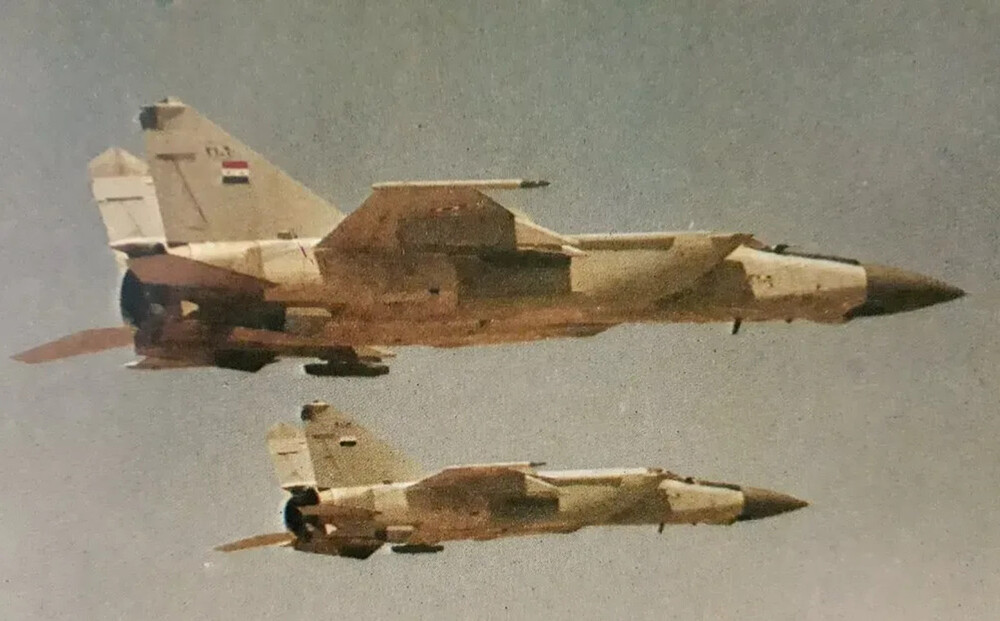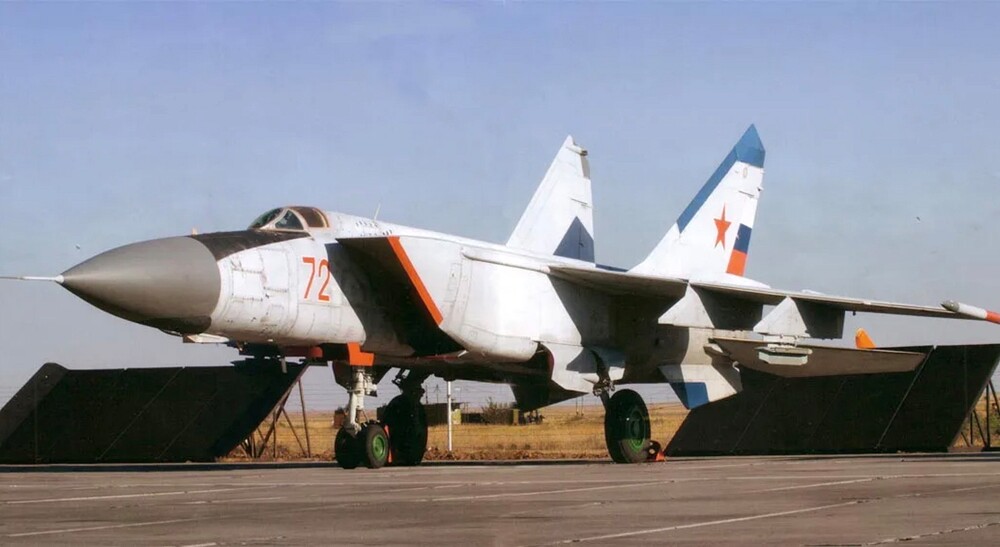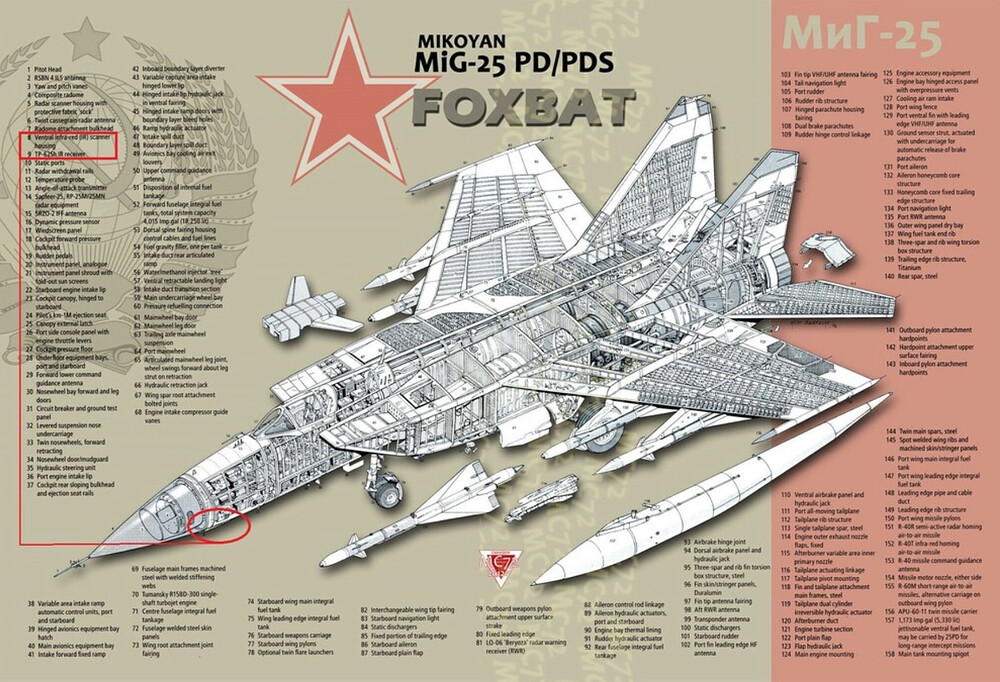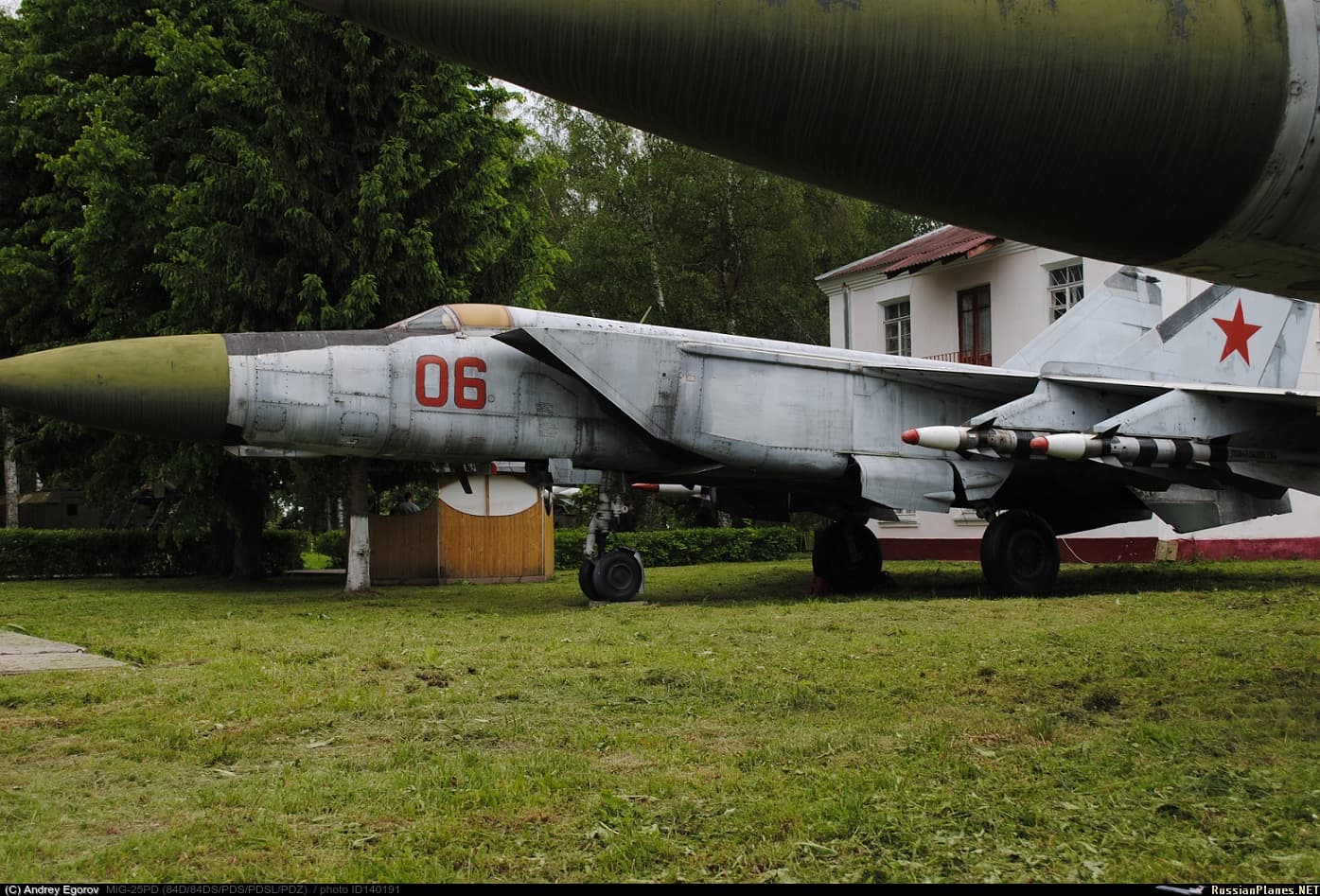Would you like to see MiG-25PD in-game?
How would you like to see MiG-25PD in-game?
- As a Premium Vehicle
- As an Event Vehicle
- As a Squadron Vehicle
- As a Tech-Tree Vehicle
- I said No
MiG-25PD “Foxbat-E”
Introduction
The MiG-25PD marked a critical turning point in the evolution of Soviet interceptor design, addressing the technological shortcomings of the original MiG-25P with a host of substantial upgrades. In response to growing concerns about Western advancements, particularly after the defection of a MiG-25P to Japan, the PD variant introduced a modernized radar system, improved infrared tracking capabilities, compatibility with newer missile types, and enhanced avionics for better combat performance. Far from a minor revision, the MiG-25PD represented a complete modernization of the platform, transforming the Foxbat into a far more capable and survivable high-speed interceptor. Its introduction restored balance in the face of advancing threats and solidified its place as one of the most potent interceptors of its era.
History
Spoiler
When the original MiG-25P entered service in the late 1960s, it was designed to intercept high-flying reconnaissance aircraft, ballistic missiles, and high-speed bombers such as the planned XB-70 Valkyrie. Although most of these American projects never reached operational service, the MiG-25P still found important roles within Soviet air defence strategy. It caused panic among Western analysts who feared it could outperform even the most advanced American aircraft, including the SR-71 Blackbird.
However, the defection of Soviet pilot Viktor Belenko to Japan in 1976 exposed several shortcomings. The MiG-25P’s radar was increasingly ineffective against low-flying targets and vulnerable to electronic countermeasures, and its R-40 missiles were unreliable at short range or in cluttered environments. They also discovered that the aircraft was not constructed entirely from titanium, which the Soviets deemed prohibitively expensive and difficult to work with; instead, it relied heavily on 80% nickel-steel alloy, 11% aluminium and 8-9% titanium. As a result, it had a turn radius “the size of Texas”, though, in fairness, it was never intended to engage in traditional dogfighting.
By the mid-1970s, the Soviet Union faced a new generation of threats: low-flying strategic bombers like the American B-1 Lancer and emerging cruise missile technologies. The Soviet PVO (Air Defence Forces) needed an interceptor that could see and kill targets at long range, under all conditions, even when enemy aircraft employed electronic jamming and terrain masking. Thus, the MiG-25PD was developed.
The MiG-25PD introduced a brand new radar, the RP-25M “Saphir-25”, capable of engaging fast, low-altitude targets while offering better resistance to ECM. It had the capability to detect targets with a radar cross-section of 16–19 m² at over 100 km range. A small TP-26Sh infrared search and track (IRST) sensor was added below the nose, a critical edge in an era where radar jamming was becoming common. The engines were upgraded to the R-15BD-300 model, improving thrust and reliability. Missiles were also modernized: its R-40R and R-40T missiles were now designated R-40RD and R-40TD, with greater resistance to countermeasures and improved engagement envelopes.
Officially entering service in 1978, the MiG-25PD restored the relevance of the Foxbat concept at a time when low-altitude penetration threatened Soviet airspace dominance. Production continued until 1982, and a substantial number of older MiG-25Ps were rebuilt to PD standard, becoming MiG-25PDS aircraft.
Characteristics
Spoiler
Structurally, the MiG-25PD retained the basic aerodynamic design of its predecessor. The aircraft still relied heavily on steel alloys rather than titanium, just like the MiG-25P, which provided excellent thermal resistance but came at the cost of considerable weight. At high altitudes, the MiG-25PD could reach speeds approaching Mach 2.83; however, operational constraints, particularly when carrying external weapons such as R-60 missiles, typically limited it to about Mach 2.5 (although the R‑60M “izdeliye 63P” missiles carried by MiG-25s were reinforced to tolerate higher thermal stress). In the bomber-reconnaissance variants, when equipped with bombs, maximum speed was also limited. For missions demanding maximum interception speed, the MiG-25PD was limited to carrying just two R-40 missiles to minimize weight and drag.
Contrary to popular belief, flying at Mach 3 and above in the MiG-25 did NOT result in permanent or irreparable engine or airframe damage. Such extreme speeds primarily reduced the service life of the engines and certain airframe components, but did not destroy them outright. In 1971, it was reported that a MiG-25 conducting a reconnaissance mission over Israel operated at full throttle to escape an interception. Upon landing, the canopy sealant had melted from the extreme heat, and ground crews were forced to pry open the cockpit with a crowbar to extract the pilot. To generate such levels of thermal stress, the aircraft must have been flying at speeds estimated around Mach 3.6, approximately 4,445 km/h, surpassing even the operational speeds of the SR-71 Blackbird according to official statistics. If verified, this would represent one of the fastest manned aircraft flights in history.
The aircraft’s unique strength lay in its ability to ascend rapidly to altitudes over 20,000 meters, a domain where few enemy aircraft could challenge it directly. However, the MiG-25PD remained a poor dogfighter by any modern standard. Its heavy weight was the main factor contributing to its poor maneuverability. This meant that its survivability in close combat depended entirely on avoiding it. Interception profiles were still built around long-range, hit-and-run tactics i.e. locate, fire, disengage.
Distinguishing Features
Spoiler
Externally, distinguishing a MiG-25P from a MiG-25PD requires careful attention to several key features.
Firstly, the MiG-25PD has a noticeably longer, more streamlined nose than the MiG-25P. This was done to make room for the larger RP-25M Sapfir-25 radar and its supporting avionics. The change pushes the tip of the radome further forward.
Another clear visual cue is the presence of the infrared search and track (IRST) sensor. The MiG-25P lacked any such system, while the MiG-25PD added it below and behind the nose cone. This IRST, although small, is the single most reliable external identifier between the two variants.
On the MiG-25PD, the weapons fit was expanded to include R-60M “izdeliye 63P” short-range infrared-guided missiles (often carried in pairs on twin launch rails alongside the main R-40 missiles), giving it a close-in dogfight option the original MiG-25P lacked. It could also carry a 5,300-liter centreline drop tank, which the MiG-25P could not. For better survivability, the PD added upgraded defensive systems, including a more modern RWR, extra RWR antennas, and chaff/flare dispensers; features the MiG-25P did not receive until its PDS upgrade.
External Fuel
Spoiler
The MiG-25PD aircraft could be fitted with a massive 5,300-liter external fuel tank that carried more fuel than the internal capacity of a MiG-23, significantly extending its operational range without severely compromising its high-speed performance.
Armament
Spoiler
The MiG-25PD carried four primary missiles: two R-40RD semi-active radar homing missiles and two R-40TD infrared-guided missiles. These weapons were optimized for high-speed, high-altitude interceptions, yet unlike their earlier counterparts, they were also capable of engaging low-flying targets with greater effectiveness. Both variants were specifically hardened against countermeasures, a weakness that had plagued the original R-40s. MiG-25PDs were also equipped with additional short-range missiles, such as the R-60M “izdeliye 63P”, a reinforced variant designed to withstand the high thermal loads associated with the aircraft’s extreme speeds. Importantly, the MiG-25PD had no internal gun and no provision for gun pods. It was entirely dependent on missile combat, embodying the principle that it would destroy its targets from extreme distance before ever entering a traditional turning fight.
MiG-25s modified to carry R-60 missiles were fitted with a primitive optical gunsight, mounted on the canopy windscreen frame at eye level. Most likely an ASP‑PFD‑21 or a closely related variant, this type of sight was installed in a similar configuration on the MiG-21PFM.
The R-40RD and R-40TD missiles were designed primarily for intercepting large, high-speed, or high-altitude targets rather than manoeuvring fighters. Their maximum effective target manoeuvring limit was around 3 to 4 G (maybe 8 G), making them suitable for engaging bombers, reconnaissance aircraft, or fighters in relatively straight flight paths. Structurally, the missiles themselves were capable of sustaining roughly 15 G during flight, but their large size and mass severely limited their agility compared to smaller missiles like the R-60. As a result, the R-40 series was not intended for dogfight scenarios; Soviet doctrine emphasized firing these weapons against targets making minimal evasive manoeuvres. While powerful and possessing a long reach, the R-40RD and R-40TD were ultimately specialized tools for a specific interception mission profile rather than versatile air combat weapons.
Nevertheless, the R-40R was capable of detecting radar returns from approximately 35 kilometres (22 miles) away. Its launch range varied depending on the engagement profile: up to 32 kilometres (20 miles) in pursuit mode and around 48 kilometres (30 miles) in a head-on engagement. The improved R-40RD variant extended the maximum launch range to approximately 77 kilometres (48 miles). The Smerch radar system featured a crucial advantage, it allowed missile launches without immediately alerting the target’s radar warning systems, meaning that by the time the enemy became aware of an incoming missile, it was often too late to react effectively.
The infrared-guided R-40T variant could track a bomber-sized target from about 29 kilometres (18 miles) away from the rear aspect and roughly 14 kilometres (9 miles) from the front. Its successor, the R-40TD, significantly improved on this performance, enabling rear-aspect engagements at distances of up to 48 kilometres (30 miles). Alongside range improvements, the R-40RD and R-40TD featured a 45% increase in warhead weight compared to the earlier versions. The original R-40 carried a warhead weighing approximately 38 kilograms (83.7 pounds), while the upgraded “D” models carried a 54-kilogram (120-pound) warhead, greatly enhancing their destructive power against large and resilient targets. Both radar and infrared versions of the R-40 family were capable of reaching speeds up to Mach 4.5, delivering between 22,700 to 27,200 kilograms-force (50,000 to 60,000 pounds-force) of thrust during powered flight.
The image shows a MiG-25PD equipped solely with R-60 missile mounts.
Interestingly, the R-40R missiles could have their proximity fuses manually deactivated by the pilot, allowing them to be used in a direct-impact mode against large airborne targets or even ground-based installations, effectively turning them into massive, high-speed, direct-fire air-to-ground rockets under specific circumstances. The R-40R series missiles were the only known weapons used by the MiG-25P series that could be employed against ground targets, and they have been confirmed to have been used in this manner during actual combat operations.
Bombs?
Spoiler
If Gaijin chooses to be flexible with loadouts, they could allow the MiG-25PD to carry FAB-250M-62T or FAB-500M-62T 500 kg bombs that were used by the MiG-25RB family. The in-game MiG-25PD could be given the option to carry bombs on its wing pylons, similar to how this Libyan MiG-25 trainer was configured. Soviet pylon systems were highly standardized, allowing for flexible loadouts across various platforms. Although, I suspect this here is a field modification (the pylons might have been locally modified).
Countermeasures
Spoiler
Compared to the original MiG-25P, the MiG-25PD featured several essential upgrades in self-defense capabilities. Notably, it was fitted with chaff and flare dispensers to enhance survivability against radar-guided and infrared-guided threats. The only confirmed chaff and flare dispensers ever equipped on MiG-25 variants were the BVP-50-60 pods, mounted over the wings. Each pod contained 30 KDS-155 cartridges. Existing images show them being equipped instead of the wing fences. These countermeasures were modest by modern standards but vital in an era where radar-guided missiles were rapidly improving. Iraqi MiG-25PD pilots made use of these to evade AIM-7 Sparrow and AIM-9 Sidewinder missiles during engagements with U.S. aircraft.
Although lacking integrated electronic warfare or advanced jamming equipment, MiG-25PD came with either SPO-10 “Sirena-3M” or SPO-15 “Beryoza” Radar Warning Receiver. The MiG-25PD’s relatively high speed and altitude performance, combined with its basic countermeasures, offered pilots a fighting chance against modern missile threats.
Service and Combat History
Spoiler
The MiG-25PD/S served primarily with the Soviet Air Defence Forces (PVO), where it replaced and supplemented the earlier MiG-25P interceptors throughout the late 1970s and 1980s. Soviet MiG-25PD/S aircraft never fired a shot in combat and were primarily used for air defence patrols, high-speed interceptions, and strategic deterrence during the Cold War. All of their known “combat” actions were intercepts without engagement.
Designed to counter high-speed, high-altitude threats such as strategic bombers and reconnaissance aircraft, the MiG-25 played a key role in the Soviet Union’s layered air defence network. Although American SR-71 Blackbirds were, on paper, somewhat superior in speed and altitude, they notably never crossed into actual Soviet airspace during their operational lifetime. This was largely due to the credible threat posed by the MiG-25 and its powerful R-40 missiles, forcing U.S. reconnaissance operations to remain just outside of the Soviet borders. In this regard, the MiG-25 succeeded fully in its primary mission, deterring intrusions into Soviet airspace without firing a shot.
On SR-71 Interception Possibility
The MiG-25PD’s improved R-40RD missile, with its extended ~77 km launch range, ~50 g boost acceleration, and Mach 4.5 top speed, made a head-on shot against the SR-71 physically feasible. In such a geometry, the combined closure rate of roughly 2.5 km/s meant the missile could theoretically reach the intercept point in about 30 seconds, provided its seeker wasn’t jammed and the SR-71 made no maneuver, even a 1–2° jink at Mach 3 creates kilometres of lateral displacement, quickly breaking the solution. In contrast, a tail-chase shot was impossible: the R-40RD’s ~3-second powered flight and 500 m/s effective overtake margin couldn’t sustain the climb and pursuit over the required ~150 seconds, especially with the MiG-25PD flying lower and slower than a Mach 3.2 SR-71 (even with a more generous powered flight the result was the same). The physics, thrust limits, and altitude gap fundamentally prevented stern-aspect interception.
Disclaimer: These calculations were performed using the data provided in this suggestion, so they should be taken with a grain of salt. Across multiple variations and recalculations, however, the conclusion was that a head-on shot was physically possible (in ideal conditions), while a tail-chase shot was not (in any conditions). This calculation also assumes that GCI detected and clearly tracked the SR-71, which in most cases they did.
Combat Abroad
Beyond the Soviet Union, the MiG-25PD was exported to several key allies, most notably Iraq, Syria and Libya, where the aircraft saw the most active and sustained combat service across a variety of operational environments.
Iraq
Spoiler
In Iraq, MiG-25s participated actively during the Iran-Iraq War, where they performed high-speed reconnaissance missions and limited air superiority tasks. Reportedly, a single IRIAF F-14 Tomcat was shot down by a MiG-25. In another incident, a MiG-25PD was shot down by an AIM-9F missile in 1983. Overall, between 1981–1986, Iraqi pilots (notably Colonel Mohammed Rayyan) reportedly scored multiple victories using MiG‑25s, including shoot-downs of F‑4s, F‑5s, a C‑130E, RF‑4, and the already mentioned F‑14.
The image above shows an Iraqi
MiG-25RB, identifiable by its sharply pointed nose. This variant was a dedicated
reconnaissance-bomber version of the MiG-25 family. They flew numerous combat sorties and suffered the highest losses among Iraqi MiG‑25 variants during the Iran–Iraq War. For more details on the different versions of the RB-series line of aircraft, see my
MiG-25BM suggestion.
Their most famous combat actions, however, occurred during the Gulf War. On the opening night of Operation Desert Storm, an Iraqi MiG-25PD achieved one of Iraq’s few confirmed air-to-air kills by shooting down U.S. Navy Lt. Cdr. Scott Speicher’s F/A-18C Hornet, using an R-40RD. Iraqi MiG-25s were also involved in other engagements during the conflict, including an incident where a MiG-25PD engaged an EF-111A Raven with three missiles, forcing it to abort its mission. As a result, an F-15C was shot down by ground fire. In another incident, a MiG-25PD successfully scored a hit on a U.S. F-15, causing damage to the fighter’s tail section. Despite the damage, the F-15 was able to maintain control and safely return to base. In 1991, a total of two MiG-25s were shot down in air combat by Coalition aircraft. These combat examples demonstrated that, even by the early 1990s, a properly flown MiG-25PD could still pose a serious threat on the modern battlefield.
Following the 1991 Gulf War, Iraqi MiG‑25s remained active during the enforcement of the Southern No-Fly Zone. On December 27, 1992, two Iraqi MiG‑25s engaged U.S. aircraft, resulting in one being shot down by a USAF F‑16 using a radar-guided missile, the first air-to-air kill for an F‑16 in U.S. service. Iraqi MiG‑25s continued to operate sporadically throughout the 1990s, though no further confirmed aerial victories or losses were recorded. In December 2002, an Iraqi MiG-25PD shot down a U.S. RQ-1B Predator unmanned aerial vehicle. By the time of the 2003 U.S.-led invasion, Iraqi MiG‑25s were grounded and did not see combat. Many were reportedly buried or hidden under sand to avoid detection and destruction by coalition forces. As a result, no MiG‑25 sorties were flown during Operation Iraqi Freedom, marking the end of the aircraft’s combat role in Iraq.
Libya
Spoiler
In Libya, MiG-25s were deployed as a critical component of the country’s air defense network, tasked with protecting Libyan airspace against repeated incursions by U.S. aircraft, and other various regional threats. The Libyan Air Force acquired a small number of MiG-25PD interceptors in the late 1970s as part of Muammar Gaddafi’s efforts to modernize his military forces and project strength across North Africa and the Mediterranean.
MiG-25s were frequently scrambled to intercept U.S. Navy reconnaissance and combat patrols, including F‑14 Tomcats. In several documented incidents, Libyan MiG‑25s approached U.S. aircraft but were deterred or escorted away without direct engagement. Despite their lack of confirmed aerial victories, the MiG‑25 played a key strategic role as a high-speed deterrent, influencing NATO operations in the region.
Remarkably, some Libyan MiG-25s survived the collapse of Gaddafi’s regime and the outbreak of the Libyan Civil War. Libya Dawn refurbished at least one MiG-25 (a two-seat MiG-25PU) and flew it in early May 2015, it crashed near Zintan during a bombing attempt (pilot ejected and was captured). in February 2018, a MiG-25PD with tail number “7012” was seen performing pre‐flight activities at the Misrata Air Base after undergoing re-activation. There are reports suggesting that a small number of MiG-25s may still be operational in Libya today, though in unknown condition.
Syria
Spoiler
During the early 1980s, the Syrian Arab Air Force deployed the MiG‑25PD/S in combat over Lebanon, where it engaged Israeli aircraft in several high-stakes encounters. Syrian MiG-25PDs clashed with Israeli F‑15 fighters on two documented occasions: February 13 and July 29, 1981. These confrontations reportedly resulted in the loss of two aircraft on each side, although Western sources typically confirm only Syrian losses. Earlier on June 13, 1981, an Israeli F‑15 shot down a Syrian MiG‑25PD with an AIM‑7 Sparrow. During Operation Mole Cricket 19 (June 9, 1982), Israel officially reported two F-15s damaged, though the cause remains uncertain. Some accounts suggest at least one was struck by an R-60 missile. The Syrian MiG‑25PDs were armed with R‑40RD/TD missiles and also employed R‑60s, though no confirmed kills, by the MiG-25s specifically, were recorded.
A small number of Syrian MiG-25s were reportedly reactivated and flown during the Syrian Civil War, despite having been mostly retired by the early 2000s due to maintenance challenges and obsolescence. In August 2012, satellite images and video footage showed MiG-25s at Tadmur Airbase, suggesting a limited return to operational status. The first confirmed post-retirement sortie occurred in February 2014, when Turkish F-16s were scrambled to intercept a Syrian MiG-25 that approached the Turkish border. Shortly after, Syrian MiG-25s have reportedly used R-40R missiles against ground targets on multiple occasions. However, due to the missiles’ age and poor maintenance, their effectiveness was limited. Some detonated prematurely, others failed to explode on impact, while the rest simply missed their intended targets. Reports suggest no significant deployments followed, and only a few aircraft remained in flyable condition, primarily at Tiyas and Tadmur. It appears all Syrian MiG-25s were grounded by spring 2020, and no active flying has been reported since.
Conclusion and Implementation
Spoiler
The MiG-25PD is a pure product of the Cold War’s speed-obsessed arms race, a machine built to intercept and destroy. In War Thunder, it would offer a unique, demanding, and rewarding style of gameplay, built around energy management, smart positioning, and long-range missile tactics rather than close-in dogfights. It’s fast, it’s powerful, but if you mishandle it, you’re done. I believe the MiG-25PD deserves its place among the top-tier interceptors in the game.
In War Thunder, the MiG-25PD could serve as the official representative of the entire MiG-25 interceptor family in the USSR tree, eliminating the need to introduce multiple Foxbat variants while still faithfully covering its historical role and capabilities. Its high speed, extreme altitude performance, and devastating missile loadout would allow it to counter aircraft like the F-14 Tomcat and operate competitively even in the upper reaches of top-tier battles. Although the MiG-31 would ultimately be a more natural fit for the Soviet tech-tree, the MiG-25PD could be introduced as a premium, event, or squadron vehicle, offering players a unique experience without disrupting the tech-tree. Such an implementation would honor the aircraft’s legacy and provide the community with one of the most iconic interceptors ever built.
Specifications
Spoiler
Crew: 1 pilot
Length: 23.82 meters
Wingspan: 14.01 meters
Height: 6.10 meters
Empty Weight: Approximately 20,000 kilograms
Maximum Takeoff Weight: 36,720 kilograms
Engines: Two Tumansky R-15BD-300 turbojet engines
Thrust: 11,200 kilograms-force (kgf) each with afterburner
Maximum Speed at Altitude: Mach 2.83+ (approximately 3,000 km/h at 20,000 meters)
(In practice, limited to Mach 2.5–2.65 when carrying R-60 missiles or external loads.)
Maximum Speed at Sea Level: Approximately ~1300+ km/h (limited by dynamic pressure and airframe stress)
Climb Rate: Approximately 208–214 meters per second (about 41,000 feet per minute)
(Exceptional at altitude; the MiG-25PD could reach operational ceiling in under 5 minutes from sea level under ideal conditions.)
Turn Rate:
- Instantaneous turn rate: ~16-18°/s
- Sustained turn rate: ~8-10°/s
G-Limit: ~4.5 G safety overload. ~11 G structural overload.
Service Ceiling: 24,000 meters (approximately 78,700 feet)
(Some flights reportedly exceeded 24,500 meters in test conditions.)
Combat Radius: Approximately 1,600 kilometers at high speed, 1,860 kilometers at optimal cruise
Ferry Range: Up to 2,575 kilometers
Target Detection Range: 100 kilometers (62 miles) +
Maximum Engagement Range: 77 kilometers (48 miles)
Primary Air-to-Air Armament:
- 2 × R-40R/RD (semi-active radar homing missiles)
- 2 × R-40T/TD (infrared-guided missiles)
Secondary Air-to-Air Armament:
- 4 or 8 × R-60M “izdeliye 63P” short-range infrared-guided missiles
Air-to-Ground Armament:
- 2 or 4 x R-40R/RD or T/TD direct-fire air-to-air rockets with deactivated proximity fuses
Optional Air-to-Ground Armament:
- 2 or 4 × FAB-250M-62T or FAB-500M-62T 500 kg general-purpose bombs (carried on wing pylons (optional))
Countermeasures:
- Chaff and Flare Pods (BVP-50-60)
- SPO-10 “Sirena-3M” or SPO-15 “Beryoza” RWR
P.S If Gaijin wish to enhance the MiG-25PD’s performance further, they could consider equipping it with the engines intended for the MiG-25M project, the R-15BF2-300 turbojets, each rated at approximately 13,000 kilograms-force of thrust with afterburner. Historically, a single MiG-25PD airframe was selected to serve as the prototype for MiG-25M testing, making this upgrade plausible from both a technical and historical standpoint. Implementing these engines would allow the MiG-25PD to achieve its maximum potential performance without requiring the addition of a separate MiG-25M variant to the game.
Main Video
Additional Videos
View
Great overview of MiG-25/31 missiles in this video:
https://www.youtube.com/watch?v=LP0uhXFoJKo
Rare footage showing a Libyan MiG-25 executing aerial manoeuvres:
https://youtu.be/wT7pahvn-aY?si=MYId4PCSF_eksL_Q
Rare archival footage of Syrian-operated MiG-25PDs:
https://www.youtube.com/watch?v=Kkjlt5ZDDVg
Sources
View
Mikoyan-Gurevich MiG-25 & MiG-31 Foxbat / Foxhound - History, Design, Performance & Dissection
Авиация и время 2004 05 [Журнал «Авиация и время»] (fb2) | КулЛиб - Классная библиотека! Скачать книги бесплатно
Libyan MiG-25: New Evidence for Preparing Libya's Dawn to Build Your Aviation
Уголок неба ¦ МиГ-25 в Ираке
Iraqi MiG-25 Foxbat Pilot explains how he was able to shoot down Lt Cdr Speicher’s F/A-18 Hornet the first night of Operation Desert Storm - The Aviation Geek Club
https://www.secretprojects.co.uk/MiG-25PD%20Flight%20and%20Combat%20Employment%20Training%20Manual-OCR.pdf
Here are some Tips for building an Accurate Model of an Iraqi MiG-25 Foxbat - The Aviation Geek Club
https://testpilot.ru/en/rossiya-e/mikoyan/
Р-60 / Р-60М - AA-8 APHID | MilitaryRussia.Ru — отечественная военная техника (после 1945г.)
Mikoyan-Gurevich MiG-25 Foxbat, and Hobbymaster Announcements.






